Somerton: The ruined medieval castle transformed into a magical family home
The sensitive restoration of a neglected medieval castle has created a delightful family home, as Nicholas Cooper discovers. Photographs by Paul Highnam.
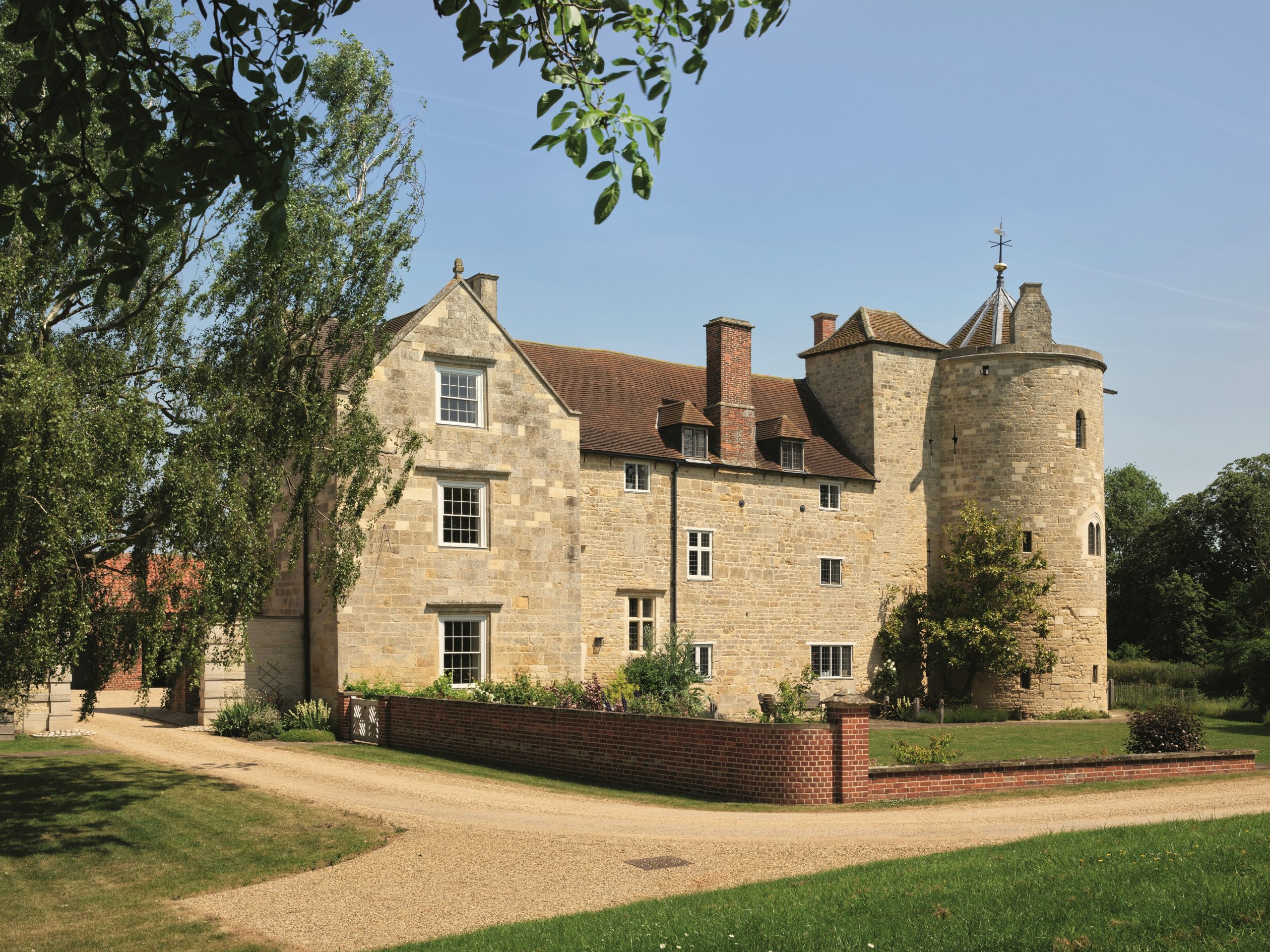

On the edge of the Fens within distant sight of Lincoln Cathedral, Somerton Castle today appears to be a handsome 17th-century house with a tower most surprisingly stuck on the end. In its mixture of the defensive and the domestic, it recalls the pele towers of the border counties of England and Scotland, but they are far away in wilder country. This little-known castle has recently undergone a transformative restoration at the hands of Hoare, Ridge & Morris architects that has not only reinvented it as a comfortable, modern family home, but rescued it from Historic England’s Heritage at Risk Register.
On May 23, 1281, a royal clerk called Anthony Bek received a royal licence to fortify his house at Somerton with walls and battlements of stone. Bek came from a local gentry family, stewards to the Earls of Lincoln, and the conversion of his house into a castle was as much an act of social advancement as architectural aggrandisement. He had entered the service of Henry III in the 1260s, before accompanying the King’s son, the Lord Edward, on Crusade. There, he became a close confidant of the future King, Edward I, and, on his return to England in 1274, began to amass rewarding offices.
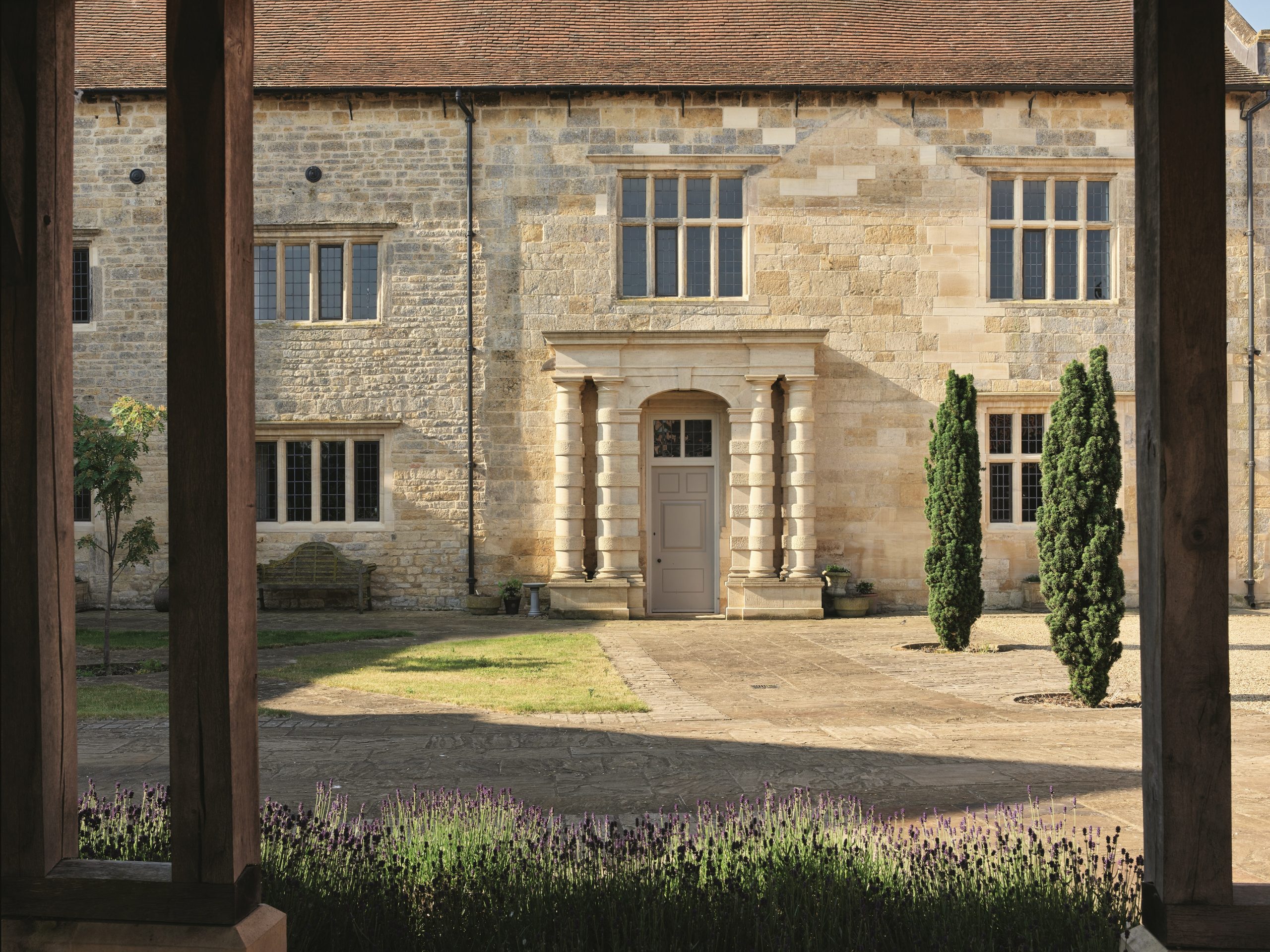
Somerton was probably conceived at about this time and the scale of the building speaks of Bek’s confidence and wealth. The castle was coherently planned, with two rectangular enclosures laid out on a figure-of-eight plan within a double moat. That to the south was perhaps fortified in timber and formed the outer or base court of the castle. The inner court was walled in stone with a tower at each corner and contained the castle’s principal domestic buildings, which were probably of timber-frame construction. Whatever the case, Bek’s own chamber almost certainly connected with — or was accommodated within — the largest of the towers, which stood at the north-east corner of the main castle enclosure.
Only the stump of this tower survives, but its 12-part basement vault speaks of the superb masonry of the whole (Fig 5). The tower also overlooked a third enclosure to the north protected by a single moat. This was almost certainly a garden and incorporated a fish pond at one end. There was a further enclosure, again perhaps a garden, beyond the base court to the south. The castle was strong and splendid, but it was also meant to be enjoyed.
Although building a castle on this scale would normally have been the crowning architectural achievement of an outstandingly successful career, Bek almost immediately outgrew Somerton. In 1283, he became Bishop of Durham, where he was, in turn, a major builder and administrative reformer. Probably in settlement of a dispute about the palatine powers he established for himself in the diocese, he gave Somerton to Edward II in 1309. The King had little use for Somerton, but, in 1359–60, it was used to accommodate John the Good, King of France, who had been captured after the battle of Poitiers. Luxurious, relatively new and relatively remote, defensible if necessary, it must have seemed the perfect prison for so distinguished a prisoner.

But, thereafter, the castle was without an obvious purpose. The rich, peaty farmland of the manor could be profitably leased out, but the castle itself could not and, over the next 250 years, scarcely anything is known of it. It was already described as ‘utterly decayed’ in 1525 and, in 1601, four local gentlemen were commissioned to inspect it. They reported that all four towers had more or less collapsed, that nothing remained of its timberwork and that the moats ‘are grown so full of sedges & mud as an hundred pounds & more will neither scour them nor fill them up’. There was no house for a lessee, but the stones ‘will serve and suffice to lay the foundations and to raise the walls of a convenient new house there for her Majesty’s farmer’. Even then, probably only the south-east tower survived to full height and, when it was illustrated by Samuel Buck in 1726, half the stair turret had already fallen away.
A new house — the eastern part of the present main range or west wing (Fig 1) — seems to have been built against the remaining tower by 1628, when Somerton was sold. It passed first to a London syndicate, to which James I owed money, and then to Sir Edward Hussey of Honington, first of a succession of local landowners who would own it thereafter. But trouble and further destruction would soon follow. In the Civil War, the area around Lincoln, Grantham and Newark was effectively a war zone and Hussey, a Royalist, complained that at Somerton Castle soldiers had ‘spoiled as much in iron, wood, glass, lead &c. as will cost in repairing £300’.
Exquisite houses, the beauty of Nature, and how to get the most from your life, straight to your inbox.

It is likely that the western part of the west wing represents a 1650s rebuilding by Hussey’s successor, Charles, who inherited it in 1648. An impressive stone door surround connects the two builds and is similar in character to a fireplace now in the hall (albeit formerly in what is today the study).
Somerton descended through the Husseys and their relatives for more than a century, but its owners’ principal seats were elsewhere and it seems generally to have been occupied as a dower house or by a close relation. However, by the 1760s, it was in the possession of the Marfleet family, prominent local farmers. To them is probably due the pretty Chinoiserie staircase (Fig 6), the re-roofing of the surviving tower, the insertion of fireplaces into the tower and a larger, Gothic window into one of its rooms. In the early 19th century, some of the 17th-century windows were sashed.
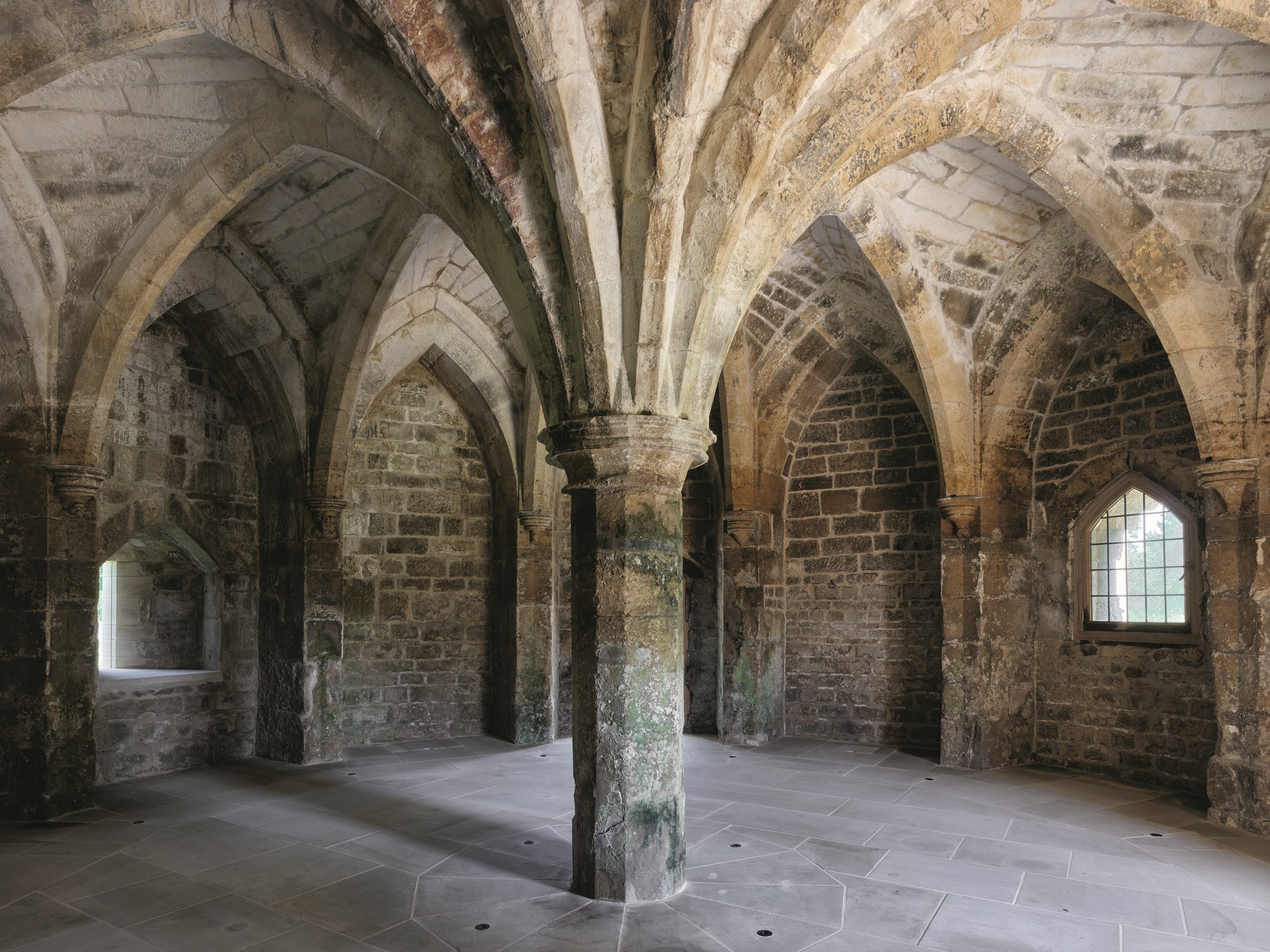
The Marfleets continued to own the castle until 1885 and the history of their farming is typical of the age. In the 1840s and 1850s, the heyday of early-Victorian ‘high farming’, they invested heavily in drainage and land improvement. In 1850, they also built fine new farm buildings that are representative of the best practice on large mixed farms of the period.
The stump of the north-west tower was demolished to build a new barn and a large waggon shed next to a rick yard. Cattle yards and byres adjoined, with stables (since demolished) and a machine shed with a horse gin close to the house. In 1871, Henry Marfleet was farming 450 acres with 10 men, six boys and nine horses and some of the workforce was accommodated in part of the castle itself. The lowest storey of the south-east tower was ideally suited as a dairy, kept cool by its thick walls and vault and the slightly sunken floor. In that year, the Marfleets built a fine new house two miles away at Boothby Graffoe, said at the time (although hardly credibly) to have cost £10,000.
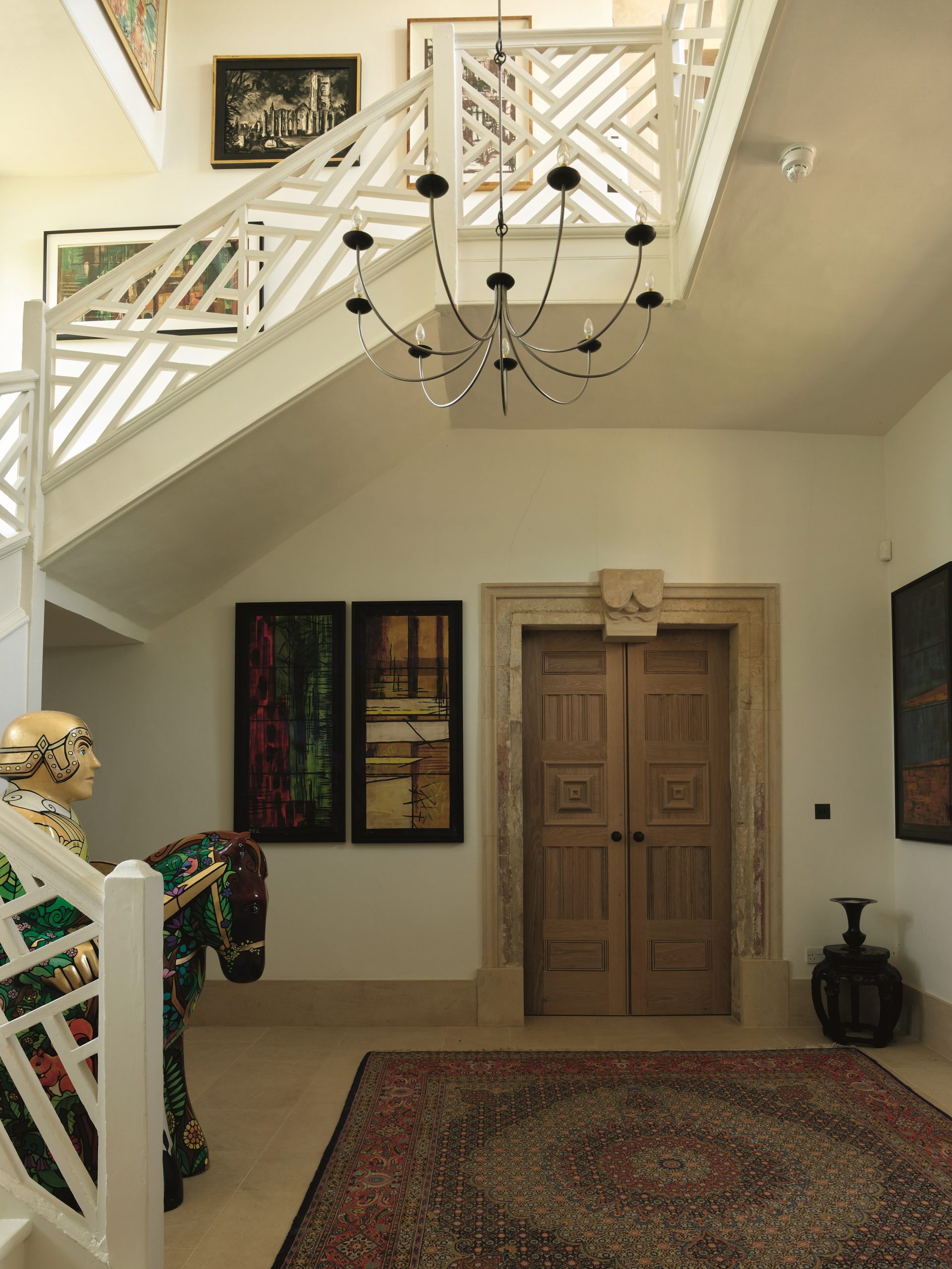
In 1885, however, perhaps already feeling the effects of the looming agricultural depression, the Marfleets sold Somerton and, for the next 50 years, it belonged to absentees who let it out or farmed through managers. When it was next farmed by a resident owner in the early 1940s, he employed only three men and three-quarters of the land was down to grass. On the other hand — as a foretaste of the coming farming revival — he owned a 20hp Fordson tractor. By then, the house also needed work after many years of piecemeal alteration, subdivision and neglect.
In the 1970s, a new owner, Christopher Thomasson, and his architect, Marshall Sisson, began to address these problems, but there followed close to another 40 years of neglect. Consequently, when Somerton was acquired in 2012 by its present owners, Graham and Kate Porter, the castle was listed Priority A on the Buildings at Risk Register. Mr Porter, a local farmer, was partly inspired to acquire Somerton because he had known the castle since his childhood. The affection that long familiarity has engendered shines through the recent work; the restoration is not only sympathetic, but its character is also caring and respectful towards the historic fabric.
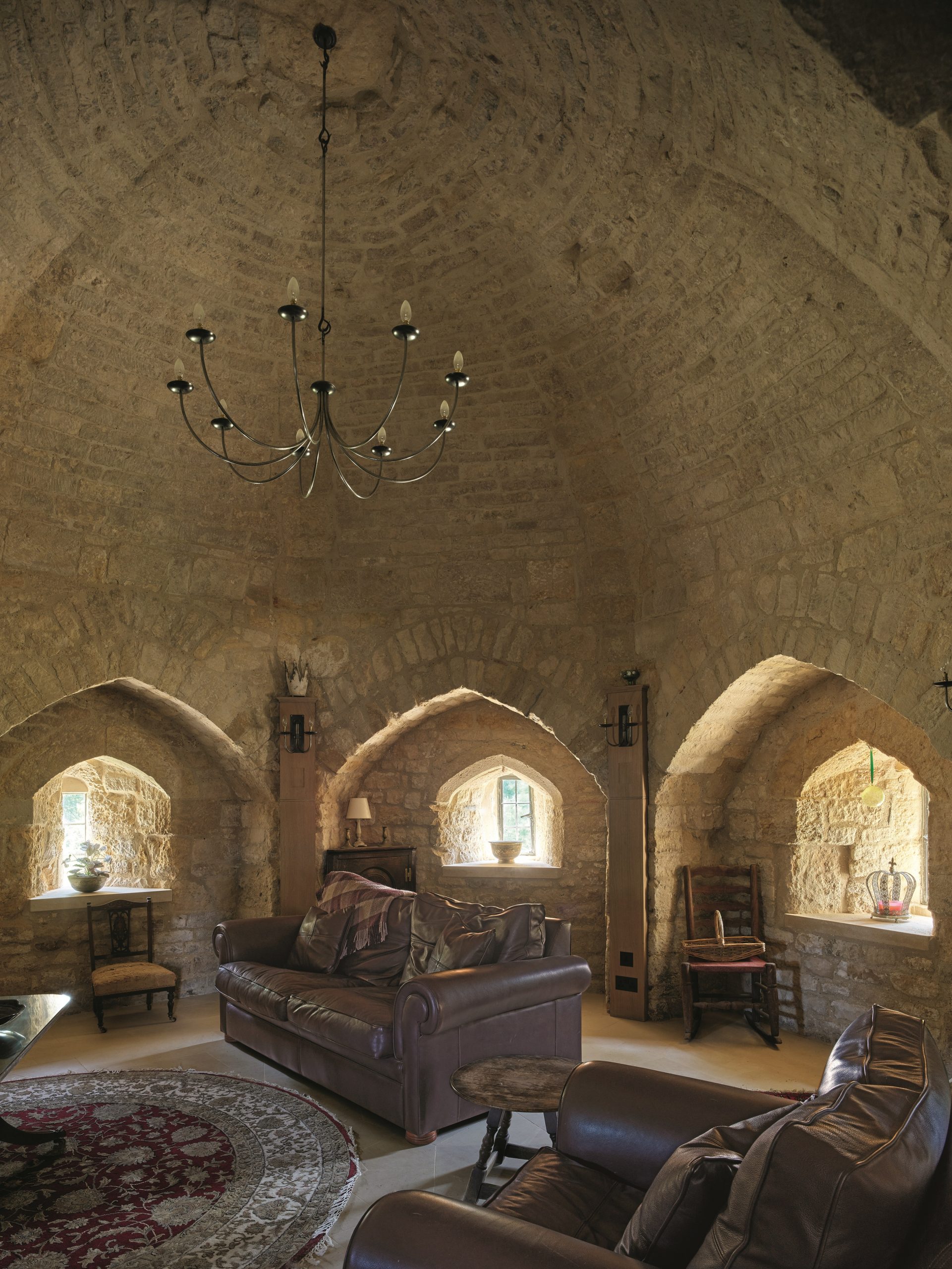
As well as being run down, the property the Porters bought was physically incoherent. The house itself was L-shaped in plan with a low 19th-century kitchen range running north at right angles to the 17th-century west range. The latter had a brick extension attached to its rear façade. Projecting at the outward angle of the house was the surviving south-eastern castle tower with its broken former stair turret rising up as a curious half-moon of masonry. Spread across the wider castle site were the many old farm buildings in varying stages of decay. There remained, too, the stumps of two medieval towers and the overgrown earthworks.
With careful planning involving Historic England, over the past decade this disorder has been resolved by stages. The presiding architect has been Mark Hoare and the main contractor Stephen D. Francis. Crucial to the project was the clearance of some of the farm structures and the replacement of the kitchen wing. This allowed for the reimagining of the interior façades of the L-shaped house plan as two sides of an entrance courtyard. To give this visual coherence, the new kitchen range was rebuilt in a 17th-century vernacular idiom with cut-stone walls and mullioned windows (Fig 8). At the same time, the brick extension to the existing range was removed, permitting the reconstitution of its original windows and the insertion of a new front door and columned porch, also in a 17th-century idiom (Fig 2).
Entrance to the courtyard has likewise been dignified with new gate piers. The courtyard itself is modestly, but formally planned, with criss-crossed paths, a pool (set over the site of a well) and a Sorbus. Defining it on a third side is an open timber pentice connecting the house with a former cart shed, now a garage and wood shed. Visible through the pentice is the orchard.
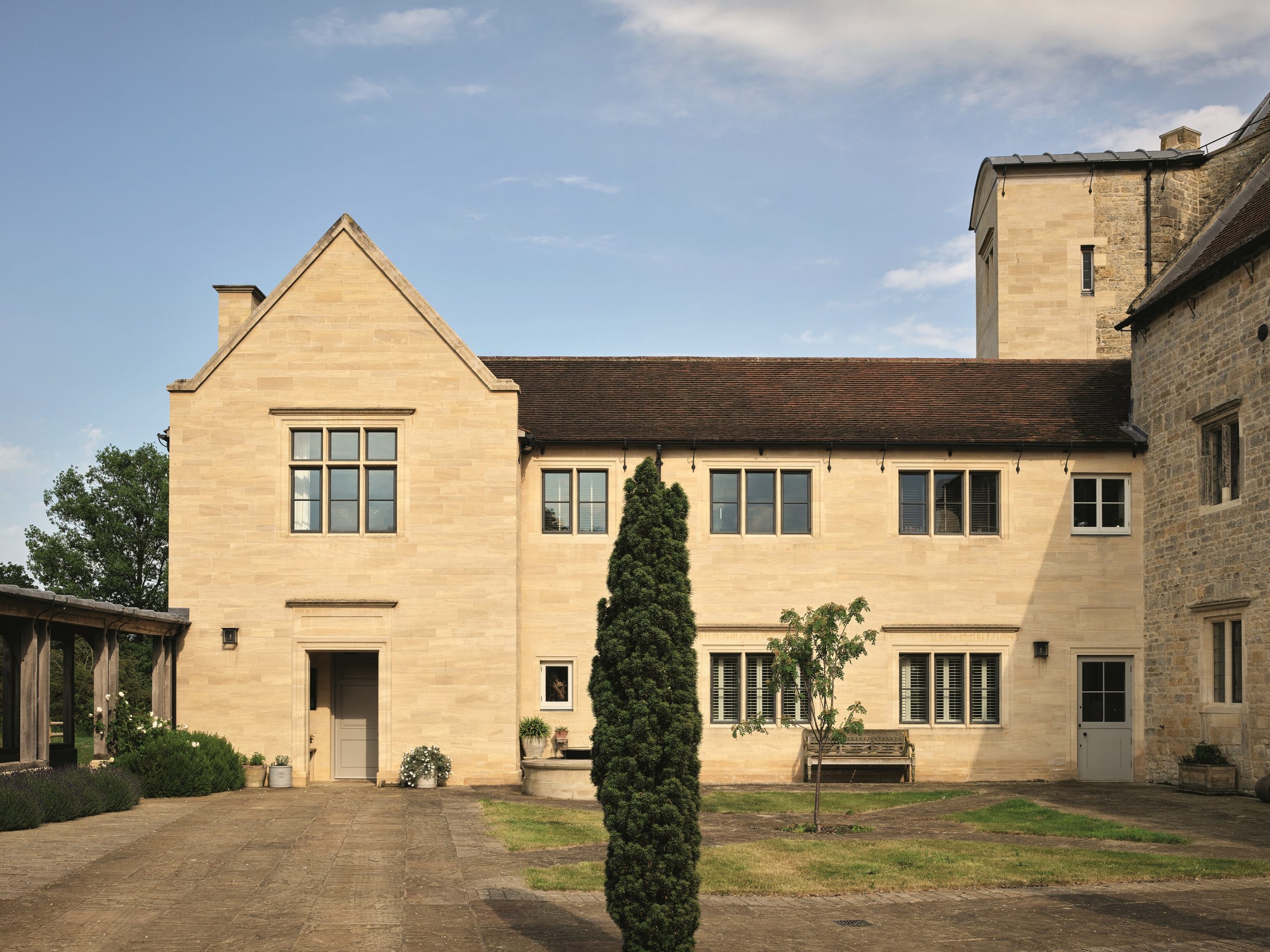
The new front porch takes the visitor into the staircase hall of the 17th-century range. The large interiors of this range have been reconstituted in their original form and sensitively restored. As part of this work, doorcases have been repaired and some historic plaster and graffiti preserved. A fine new study has also been created on the ground floor, furnished with oak shelves and cupboards (Fig 3), one of several rooms with handsome, custom-made joinery in oak.
On a day-to-day basis, however, the main entrance to the house is through a door in the new kitchen wing. The kitchen enjoys outward views across the countryside, as well as access to a small garden within the line of the moat. Inside the volume of the kitchen is the rebuilt base of the medieval stair turret to the rear of the surviving tower. This turret has been rebuilt to its full height in limestone and rises to the circular master bedroom on the first floor (the latrine chamber attached now serves as a modern bathroom) and then to a re-floored prospect chamber above that. The latter preserves inbuilt window seats to enjoy the views.
Opening off the kitchen at ground-floor level is the vaulted tower basement, which now serves as a family television room (Fig 7). Throughout the internal renovations, modern gypsum and cement plasters have been removed from the walls. These have then been insulated with breathable wood-fibre insulation and finished with lime plaster.
The remaining farm buildings and medieval tower bases have been repaired and re-ordered with similar care. That to the south-west has been restored and its first floor repaved to create a raised terrace. It overlooks a lawn within what was once a section of the south moat and is connected to the surrounding buildings by a second timber pentice with turned Tuscan timber columns (Fig 4). Finally, the deteriorating stump of the north-east tower has been refaced in stone and roofed over for protection.
In this one building is expressed the entire recent journey of the castle as a whole from ruin to resurrection. Somerton is an exemplary essay in how to transform the jumbled remains of a complex and ancient building into a coherent, contemporary house.
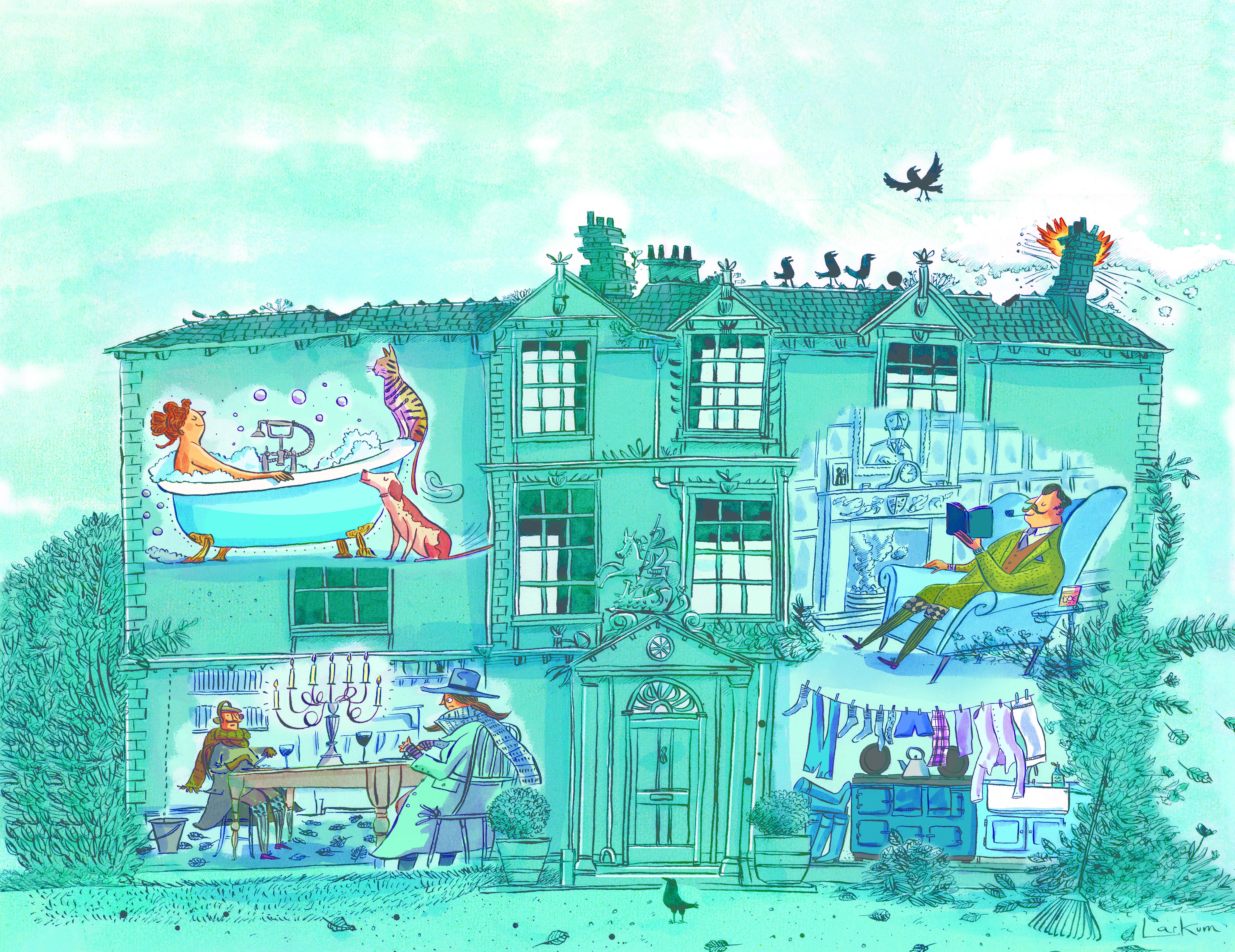
10 ways to insulate a period property
Modern technology might offer sustainable, cost-effective heat sources, but the best-value unit of energy is the one you don’t lose
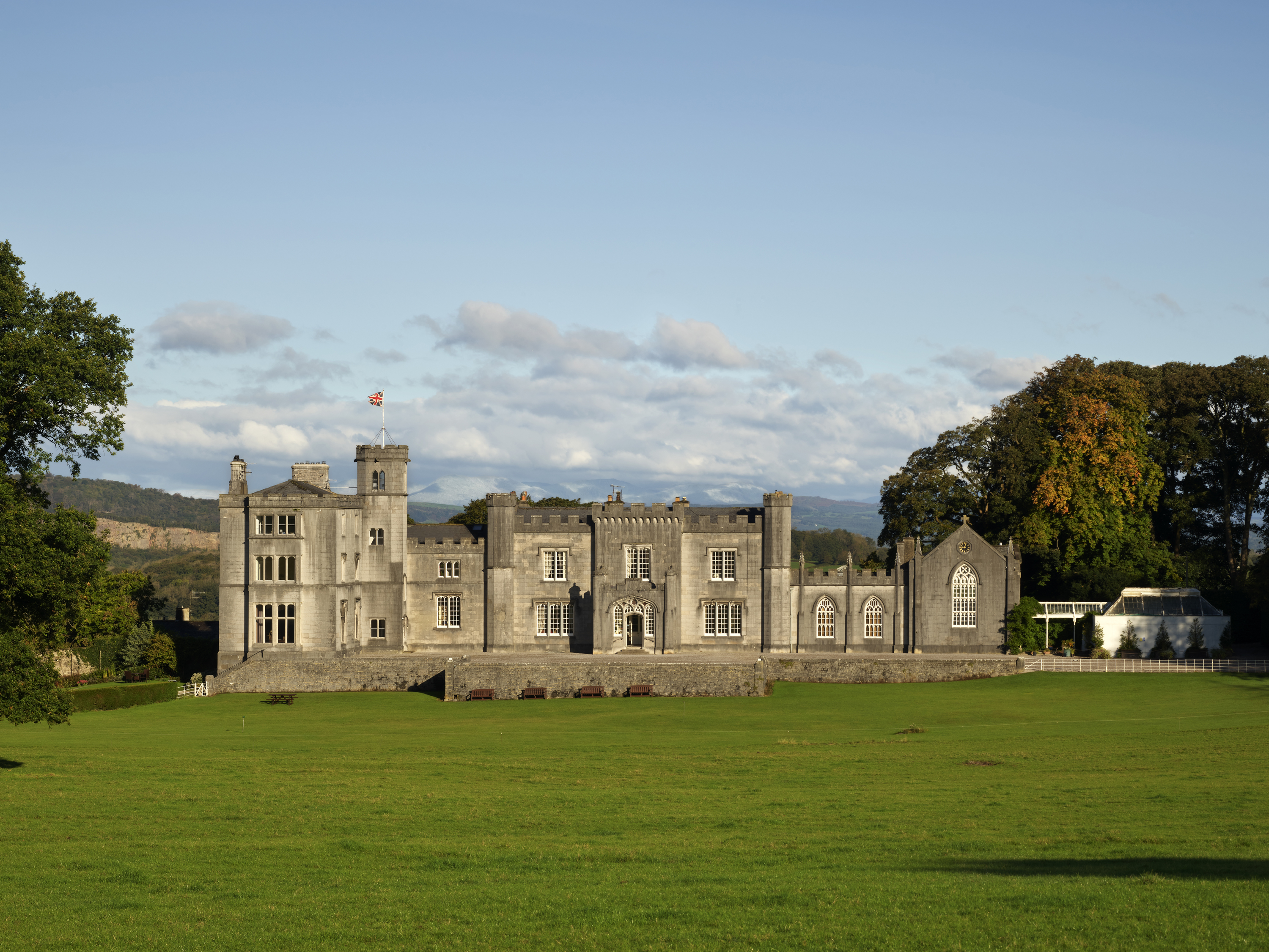
Britain's great country house revival — and how it was boosted by the unintended consequence of a temporary tax measure
To celebrate the 50th birthday of Historic Houses, director-general Ben Cowell considers the unlikely importance of tax policy as a

St James's Palace: An exclusive look inside the British monarchy's oldest, quirkiest and most mysterious palace
Created as a secure residence for Henry VIII’s heir, St James’s Palace has become the modern home of the Court.
Country Life is unlike any other magazine: the only glossy weekly on the newsstand and the only magazine that has been guest-edited by His Majesty The King not once, but twice. It is a celebration of modern rural life and all its diverse joys and pleasures — that was first published in Queen Victoria's Diamond Jubilee year. Our eclectic mixture of witty and informative content — from the most up-to-date property news and commentary and a coveted glimpse inside some of the UK's best houses and gardens, to gardening, the arts and interior design, written by experts in their field — still cannot be found in print or online, anywhere else.
